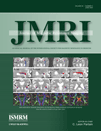ToF-SWI: Simultaneous time of flight and fully flow compensated susceptibility weighted imaging
Abstract
Purpose
To perform systematic investigations on parameter selection of a dual-echo sequence (ToF-SWI) for combined 3D time-of-flight (ToF) angiography and susceptibility weighted imaging (SWI).
Materials and Methods
ToF-SWI was implemented on 1.5 T and 3 T MR scanners with complete 3D first-order flow compensation of the second echo. The efficiency of flow compensating the SWI echo was studied based on phantom and in vivo examinations. Arterial and venous contrasts were examined in volunteers as a function of flip angle and compared with additionally acquired single-echo ToF and single-echo SWI data.
Results
Complete flow compensation is required to reduce arterial contamination in the SWI part caused by signal voids. A ramped flip angle of 20° depicted arteries best while venous contrast was preserved. Comparing ToF-SWI with single-echo ToF demonstrated arteries with similar quality and delineated all major arteries equally well. Venous delineation was degraded due to lower SNR associated with the thinner slabs used with ToF-SWI compared to single-echo SWI acquisition.
Conclusion
A dual-echo sequence (ToF-SWI) with full flow compensation of the second echo in a single scan is feasible. This sequence allows simultaneous visualization of intrinsically coregistered arteries and veins without spatial mis-registration of vessels caused by oblique flow and with minimal signal loss in arteries. J. Magn. Reson. Imaging 2009;29:1478–1484. © 2009 Wiley-Liss, Inc.




